
Vincent Willem van Gogh was a Dutch Post-Impressionist painter who is among the most famous and influential figures in the history of Western art. In just over a decade, he created approximately 2100 artworks, including around 860 oil paintings, most of them in the last two years of his life. His oeuvre includes landscapes, still lifes, portraits, and self-portraits, most of which are characterized by bold colors and dramatic brushwork that contributed to the rise of expressionism in modern art. Van Gogh's work was beginning to gain critical attention before he died at age 37, by what was suspected at the time to be a suicide. During his lifetime, only one of Van Gogh's paintings, The Red Vineyard, was sold.

Charles-François Daubigny was a French painter, one of the members of the Barbizon school, and is considered an important precursor of impressionism.
The year 1890 in art involved some significant events.

Wheatfield with Crows is a July 1890 painting by Vincent van Gogh. It has been cited by several critics as one of his greatest works.

The Church at Auvers is an oil painting created by Dutch post-impressionist artist Vincent van Gogh in June 1890 which now hangs in the Musée d'Orsay in Paris, France.

Auvers-sur-Oise is a commune in the department of Val-d'Oise, on the northwestern outskirts of Paris, France. It is located 27.2 km (16.9 mi) from the centre of Paris. It is associated with several famous artists, the most prominent being Vincent van Gogh (1853–1890). This was the place where Van Gogh died.

Vincent van Gogh made many copies of other people's work between 1887 and early 1890, which can be considered appropriation art. While at Saint-Paul asylum in Saint-Rémy-de-Provence, France, where Van Gogh admitted himself, he strived to have subjects during the cold winter months. Seeking to be reinvigorated artistically, Van Gogh did more than 30 copies of works by some of his favorite artists. About twenty-one of the works were copies after, or inspired by, Jean-François Millet. Rather than replicate, Van Gogh sought to translate the subjects and composition through his perspective, color, and technique. Spiritual meaning and emotional comfort were expressed through symbolism and color. His brother Theo van Gogh would call the pieces in the series some of his best work.
A double-square painting is a painting made on uncommonly large canvases, which have one dimension that is twice the size of the other. Vincent van Gogh used 50 cm × 100 cm double-squares almost exclusively during the final weeks of his life in Auvers, in June and July 1890. Other artists who have painted double-square canvases include Charles-François Daubigny, Puvis de Chavannes, and Ivon Hitchens.
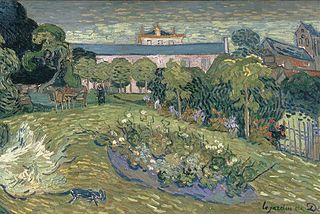
Daubigny's Garden, painted three times by Vincent van Gogh, depicts the enclosed garden of Charles-François Daubigny, a painter whom Van Gogh admired throughout his life.
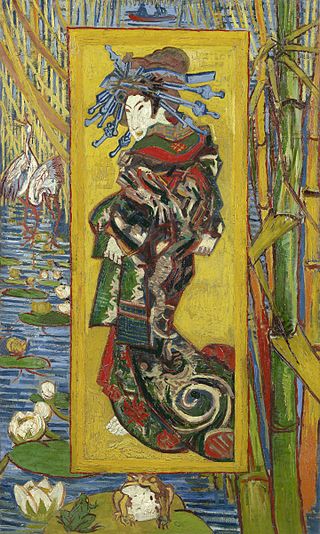
Japonaiserie was the term used by Dutch post-impressionist painter Vincent van Gogh to express the influence of Japanese art on his works.
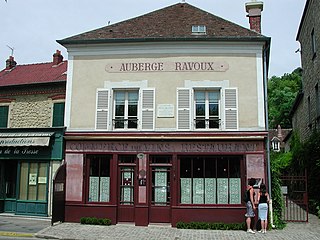
The Auberge Ravoux is a French historic landmark located in the heart of the village of Auvers-sur-Oise. It is known as the House of Van Gogh because the Dutch painter Vincent van Gogh spent the last 70 days of his life as a lodger at the auberge. During his stay at Auvers, Van Gogh created more than 80 paintings and 64 sketches before shooting himself in the chest on 27 July 1890 and dying two days later on 29 July 1890. The auberge (inn) has been restored as a museum and tourist attraction. The room where Van Gogh lived and died has been restored and can be viewed by the public.

Wheat Fields is a series of dozens of paintings by Dutch Post-Impressionist artist Vincent van Gogh, borne out of his religious studies and sermons, connection to nature, appreciation of manual laborers and desire to provide a means of offering comfort to others. The wheat field works demonstrate his progression as an artist from the drab Wheat Sheaves made in 1885 in the Netherlands to the colorful and dramatic 1888–1890 paintings from Arles, Saint-Rémy and Auvers-sur-Oise in rural France.

Dr. Gachet's Garden in Auvers and Marguerite Gachet in the Garden were both painted in 1890 by Vincent van Gogh in the gardens of his homeopathic physician, Dr. Paul Gachet. Both paintings reside at the Musée d'Orsay.

The death of Vincent van Gogh, the Dutch Post-Impressionist painter, occurred in the early morning of 29 July 1890 in his room at the Auberge Ravoux in the village of Auvers-sur-Oise in northern France after possibly shooting himself two days earlier.

Tree Roots is an oil painting by Vincent van Gogh that he painted in July 1890 when he lived in Auvers-sur-Oise, France. The painting is an example of the double-square canvases that he employed in his last landscapes.

Houses at Auvers is an oil painting by Vincent van Gogh. It was created towards the end of May or beginning of June 1890, shortly after he had moved to Auvers-sur-Oise, a small town northwest of Paris, France.

Rain is an oil-on-canvas painting by Vincent van Gogh, created in 1889, while he was a voluntary patient at an asylum in Saint-Rémy-de-Provence. He repeatedly painted the view through the window of his room, depicting the colours and shades of the fields and hills around Saint-Rémy as they appeared at various times of day and in varying weather conditions. Rain measures 73.3 cm × 92.4 cm and is held by the Philadelphia Museum of Art in the United States.
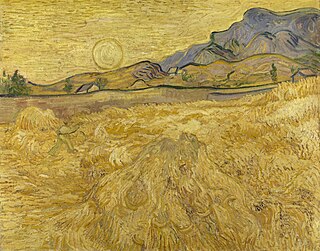
Reaper, Wheat Field with Reaper, or Wheat Field with Reaper and Sun is the title given to each of a series of three oil-on-canvas paintings by Vincent van Gogh of a man reaping a wheat field under a bright early-morning sun. To the artist, the reaper represented death and "humanity would be the wheat being reaped". However, Van Gogh did not consider the work to be sad but "almost smiling" and taking "place in broad daylight with a sun that floods everything with a light of fine gold".

Wheatfield Under Thunderclouds is an 1890 oil painting by Vincent van Gogh. The painting measures 50.4 cm × 101.3 cm. It depicts a relatively flat and featureless landscape with fields of green wheat, under a foreboding dark blue sky with a few heavy white clouds. The horizon divides the work almost into two, with shades of green and yellow below and shades of blue and white above. Since 1973 it has been on permanent loan to the Van Gogh Museum in Amsterdam.
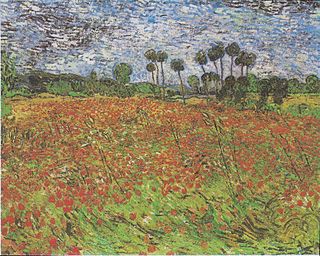
Poppy Field is an 1890 painting by the Dutch artist Vincent van Gogh, painted around a month before his death during his stay in Auvers-sur-Oise, France. It has been described as "a composition that verges on the abstract" and shows marked difference from a 1888 painting of the same subject that now is in the Van Gogh Museum, in Amsterdam. Spending many years in Germany, the painting now hangs in the Kunstmuseum, in The Hague.




















